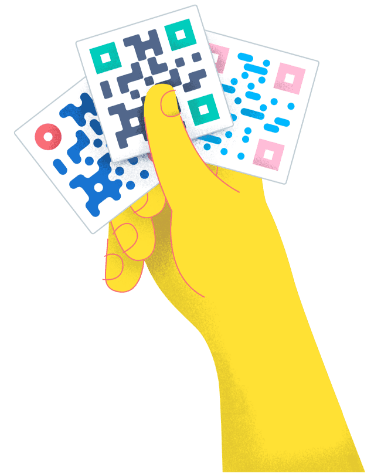- Best Practices ●
- COVID-19 ●
- Industry Trends ●
- Partners ●
- Product ●
Smart Packaging Basics: Types and Benefits
In an ever-evolving technological landscape, the brilliance of smart packaging design keeps on—well—getting smarter. From manufacturers to retailers and beyond, smart packaging technology is revolutionizing the packaging industry.
Let’s explore the ins and outs of smart packaging and how it can help you with business operations.
-
Table of contents
- What is smart packaging?
- Types of smart packaging
- 7 benefits of smart packaging
What is smart packaging?
Smart packaging employs technology like QR Codes, radio frequency identity (RFID) tags, near-field communication(NFC) chips, and other software to improve packaging functions.
Their advanced capabilities help with linking consumers, manufacturers, retailers, and other stakeholders between the physical packaging and the digital world.
Discover the battle of NFC vs. QR Codes and RFID vs. QR Codes on our blog!
Types of smart packaging
Smart packaging can be broken down into three groups: active packaging, intelligent packaging, and connected packaging. Let’s unpack this more in-depth.
Active packaging
Active packaging employs a blend of materials and substances within its packaging to extend product shelf life and preserve content quality.
It works by absorbing unwanted compounds, releasing specific ones, and preventing microbial growth. Additionally, it regulates temperature, oxygen levels, and moisture within the packaging.
An example of this smart packaging technology is Carbon Dioxide Emitters. It’s commonly used in packaging for fresh produce, slowing down bacterial growth and fruit ripening and improving pigmentation retention.
Intelligent packaging
Intelligent packaging enhances product functionality by incorporating smart packaging technology like RFID tags and NFCs. This technology enables product monitoring, including real-time assessment of factors such as freshness, temperature, and storage conditions.
Some smart packaging technologies use color-changing indicators with special inks. These indicators react to environmental changes and quickly alert users to any variations that might affect product quality.
Connected Packaging
Connected packaging is an interactive form of smart packaging that allows brands to engage directly with customers through smartphones.
By leveraging technologies such as RFIDs, microchips, and QR Codes, companies can enhance customer engagement, leading to meaningful connections—hence the term “connected packaging.”
Connected packaging enables data collection about customers, empowering brands to deliver personalized experiences. It also provides opportunities for customers to engage with the brand pre-purchase, explore product details, and access additional value beyond the product itself.
7 benefits of smart packaging
Smart packaging technology offers businesses countless benefits, from extending shelf life to real-time tracking and better brand experiences. With its advantages outweighing any drawbacks, it’s a must-have tool for innovation.
1. Enhanced Product safety and quality
After the manufacturing process, products are carefully packaged and begin their journey toward the checkout counter. Smart packaging technology plays a pivotal role in this journey by incorporating advanced sensors and software.
These components work in tandem to monitor and track the internal environment of the packaged products.
Using sensors and software, manufacturers can detect and address potential issues such as changes in temperature, humidity, or other environmental factors throughout the product packaging journey.
For example, in the food industry, smart packaging technology ensures that perishable items remain within optimal temperature ranges during transportation and storage, extending their shelf-life and reducing the risk of spoilage.
2. More sustainable for the planet
By using smart packaging, companies can not only diminish product loss and waste but also streamline costs. Take, for instance, the integration of smart labels with QR Codes, a tool increasingly adopted by players in the food industry to enhance supply chain management.
QR Codes provide access to vital data, enabling real-time monitoring, precise inventory control, and automated alerts. These notifications inform stakeholders of spoilage incidents, facilitating swift product recalls to eliminate damaged items that could jeopardize the supply chain.
With this technology, companies can lighten their workload, reduce expenses, and curtail product losses—all while prioritizing sustainability. It’s a win-win situation, saving both resources and the planet!
Dive into how QR Code inventory management helps to improve supply chain efficiency.
3. Better brand transparency
The demand for transparency and conscious consumption has grown in leaps over the years, particularly among younger generations of consumers.
Smart packaging presents businesses with valuable opportunities to not only gain insight into their transparency practices throughout the supply chain but also to communicate these practices directly through their packaging.
NFC tags are now commonly integrated into product packaging to provide detailed information about products while also assisting warehouse stakeholders in tracking and monitoring products across the supply chain.
Similarly, QR Codes are emerging as a powerful tool for enhancing brand transparency. By incorporating a product QR Code onto the packaging, companies can share volumes of information, ranging from ingredient sourcing and brand values to insights into the product’s life cycle.
4. Offers counterfeit protection
Counterfeiting, the unauthorized replication of a brand’s trademark to mimic its products, poses a global challenge for businesses and consumers alike.
Fortunately, companies can now use smart packaging technology to deter imitation and tampering with their products.
Through the integration of watermarks, RFID tags, NFC tags, security seals, holograms, and other emerging technologies, brands can track and verify the authenticity of their products, providing an additional layer of protection.
Ultimately, smart packaging technology not only safeguards the product itself but also preserves the brand’s reputation, fostering greater consumer trust in the brand.
5. More accurate product predictions
Smart packaging technology, such as predictive inventory management, helps companies forecast when their products are running low or at out-of-stock levels. Certain tools can even automate these processes and send push notifications, alleviating the workload for companies.
Depending on the chosen smart packaging software, companies can set up email alerts to inform customers directly when products are out of stock.
This proactive communication not only enhances the customer experience by ensuring that they have their products as soon as they run out but also helps companies manage stockouts more efficiently, allowing for better inventory management and a more satisfied customer.
6. Stronger brand loyalty
Smart packaging offers a dynamic platform for showcasing your brand narrative. Harnessing features like QR Codes, brands can weave their story through innovative solutions such as a Video QR Code, an immersive augmented reality experience, or an enticing loyalty program via a Coupon QR Code.
In today’s market, customers crave interactive engagements that resonate with them on an emotional level. QR Codes are the ideal conduit for delivering memorable, educational, and inspiring experiences, which can lead to repeat purchases and lasting connections.
7. Improved consumer connections
Using smart packaging technology like QR Codes opens up a direct communication line between your products and your customers. But did you know about the 2D Barcode, a powerful enhancement to make your packaging even smarter?
The 2D Barcode, a type of QR Code solution, allows you to include a Global Trade Item Number (GTIN) on your packaging so you can print GS1-compliant barcodes on your product packaging.
More than that, it lets you attach a custom link of your choice, allowing customers to access content about your product within seconds on their smartphones. To top that off, you’ll also be able to view scan metrics that provide valuable insights into customer behavior.
From determining which locations by city and country are generating the most amount of traffic, to identifying the total amount of scans versus the unique scans and more, QR Code tracking helps you discover which products are resonating the most with your customers.
Learn more about why we created the 2D Barcode!
Start your smart packaging journey with QR Code Generator PRO
Are you ready to step into the future of smart packaging alongside a reliable partner? QR Codes offer a straightforward solution for product tracking, elevating brand transparency, delivering personalized experiences, and so much more.
And here’s the kicker: With the QR Code Generator, not only can you create GS1-compliant barcodes with our 2D Barcode, but you can also share branded content to engage customers with your brand at the same time!
Sign up for QR Code Generator Pro today and gain a competitive edge!





